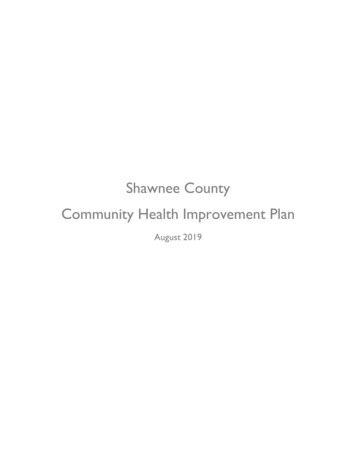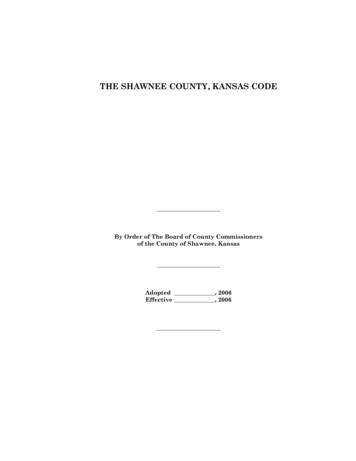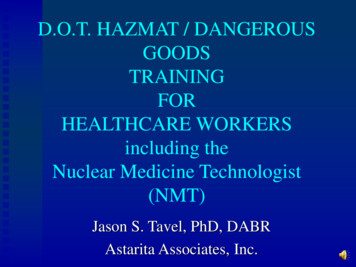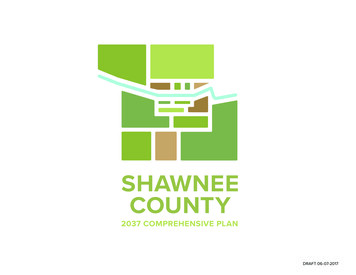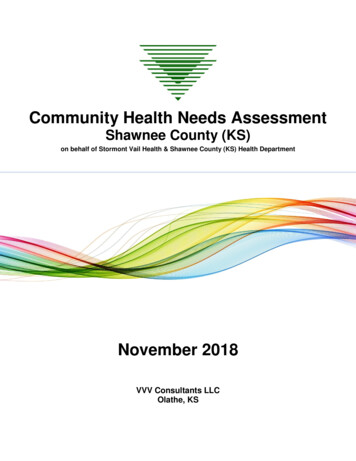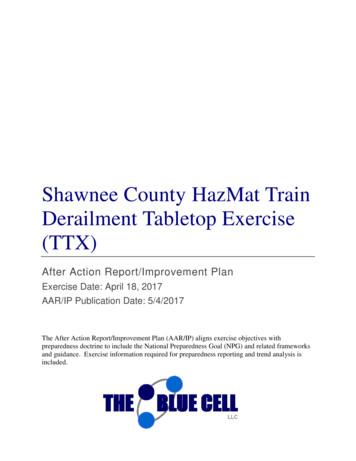
Transcription
Shawnee County HazMat TrainDerailment Tabletop Exercise(TTX)After Action Report/Improvement PlanExercise Date: April 18, 2017AAR/IP Publication Date: 5/4/2017The After Action Report/Improvement Plan (AAR/IP) aligns exercise objectives withpreparedness doctrine to include the National Preparedness Goal (NPG) and related frameworksand guidance. Exercise information required for preparedness reporting and trend analysis isincluded.
After Action Report/Improvement Plan (AAR/IP)HazMatTrain DerailmentTabletop Exercise (TTX)EXERCISE OVERVIEWExercise NameHazMat Train Derailment Tabletop Exercise (TTX)Exercise DatesApril 18th, 2017, from 1000 to 1600.ScopeThis exercise was a tabletop exercise, that took place from 1000 to 1600 atReynolds Lodge, Lake Shawnee, 3315 SE Tinman Cir, Topeka, KS 66605.Exercise play was limited to law enforcement, fire, EMS, emergencymanagement, hospital, emergency support functions, public health, and otherpublic and private partnersPurposeThe purpose of this exercise was to discuss plans, policies and proceduresamong local response organizations, increase familiarity with one another'splans, and to identify strategies for improvement. Participants wereinstructed to focus discussion on strategic, policy-level decisions and actions.Threat orHazardSponsorsPoint of ContactExercise OverviewTrain derailment with hazardous materials spill The Blue Cell LLC The NIMS StoreThe Blue Cell, LLC, 19062 East Union Drive., Aurora, CO 80015, (800)866-08401Shawnee County Emergency ManagementHomeland Security Exercise and Evaluation Program (HSEEP)
After Action Report/Improvement Plan (AAR/IP)HazMatTrain DerailmentTabletop Exercise (TTX)ANALYSIS OF CORE CAPABILITIESAligning exercise objectives and core capabilities provides a consistent taxonomy for evaluationthat transcends individual exercises to support preparedness reporting and trend analysis. Theexercise objectives, aligned core capabilities, and performance ratings for each core capability asobserved during the exercise and determined by the evaluation team are identified below.ObjectiveCore CapabilityDiscuss the process for communicationsinteroperability and redundancy among allparticipating agencies and organizations, inaccordance with current communications protocols.PerformanceRating (P, S,M, U)SOperationalCommunicationsSIdentify strategies to establish and maintain acommand structure and process that integrates allcritical stakeholders, in accordance with currentplans, policies, and procedures.Operational CoordinationPrioritize available resources to support the incidentand identify resource needs by type to supportongoing operations.Operational CoordinationSSIdentify strategies to deliver prompt and reliableinformation regarding any threats, actions beingtaken, and any assistance being made available, inaccordance with plans, policies, and procedures.Public Information andWarningAssess and manage consequences of a hazmatrelease and mitigate effects of hazardous materials.Environmental Response /Health and SafetyDiscuss strategies to provide lifesaving medicaltreatment, transport, sheltering, and mental healthservices during a mass casualty/fatality event.Public Health and MedicalServicesSSRatings Definitions: Performed without Challenges (P): The targets and critical tasks associated with the core capability werecompleted in a manner that achieved the objective(s) and did not negatively impact the performance of otheractivities. Performance of this activity did not contribute to additional health and/or safety risks for the public orfor emergency workers, and it was conducted in accordance with applicable plans, policies, procedures,regulations, and laws. Performed with Some Challenges (S): The targets and critical tasks associated with the core capability werecompleted in a manner that achieved the objective(s) and did not negatively impact the performance of otheractivities. Performance of this activity did not contribute to additional health and/or safety risks for the public orfor emergency workers, and it was conducted in accordance with applicable plans, policies, procedures,regulations, and laws. However, opportunities to enhance effectiveness and/or efficiency were identified. Performed with Major Challenges (M): The targets and critical tasks associated with the core capability werecompleted in a manner that achieved the objective(s), but some or all of the following were observed:demonstrated performance had a negative impact on the performance of other activities; contributed toadditional health and/or safety risks for the public or for emergency workers; and/or was not conducted inaccordance with applicable plans, policies, procedures, regulations, and laws. Unable to be Performed (U): The targets and critical tasks associated with the core capability were notperformed in a manner that achieved the objective(s).Analysis of Core Capabilities2Shawnee County Emergency ManagementHomeland Security Exercise and Evaluation Program (HSEEP)
After Action Report/Improvement Plan (AAR/IP)HazMatTrain DerailmentTabletop Exercise (TTX)Objective 1:Discuss the process for communications interoperability and redundancy among all participatingagencies and organizations, in accordance with current communications protocols. Core Capability: Operational CommunicationsStrengthsThe partial capability level can be attributed to the following strengths: Strength 1: Individual agencies have a good working knowledge of their individualcommunication processes. Strength 2: Participants quickly addressed issues of 911 and dispatch inundation. Strength 3: Participants understand local and state radio templates.Areas for ImprovementThe following areas require improvement to achieve the full capability level:o Area for Improvement 1: Utilizing state radio templateso Reference: Office of Emergency Communications websiteo Analysis: While participants understand there are radio templates, further trainingon their use is needed.o Area for Improvement 2:Use of Virtual EOCo Reference: Shawnee County EOPo Analysis: Proficiency training on use of Virtual EOC through multiple platformsi.e.; phone, computer, etc.o Area for Improvement 3: How to implement conventional vs trunked radiocommunicationo Reference: SNCO CECC plan DRAFTo Analysis: Recognizing the trigger point to request radio changes to accommodateadditional trafficAnalysis of Core Capabilities3Shawnee County Emergency ManagementHomeland Security Exercise and Evaluation Program (HSEEP)
After Action Report/Improvement Plan (AAR/IP)HazMatTrain DerailmentTabletop Exercise (TTX)Objective 2:Identify strategies to establish and maintain a command structure and process that integrates allcritical stakeholders, in accordance with current plans, policies, and procedures. Core Capability: Operational CoordinationStrengthsThe partial capability level can be attributed to the following strengths: Strength 1: Quickly worked together to determine objectives and needs for incidentcontrol. Strength 2: Participants worked well in Unified Command structure Strength 3: Broad range of participants allowed for breakout into ESF groups, providingmore specific involvement from individuals and agencies.Areas for ImprovementThe following areas require improvement to achieve the full capability level:o Area for Improvement 1: Ability to quickly and decisively set up commandstructure and determine if/when Unified Command should be used.o Reference: NIMS/ICSo Analysis: ICS refresher - identify IC and jurisdictional ownershipo Area for Improvement 2: Activation/notification of Public Works, Fire MutualAid, VOAD's, State Fire Marshal, and other pertinent State and local assetsshould take place early in response phase.o Reference: SNCO/City of Topeka EOP, CECC protocolo Analysis: Develop redundant follow up notification protocol/process after initialvirtual EOC notificationo Area for Improvement 3: Relaying of information from operations to EOC forthe Common operation picture - i.e.; hot/warm/cold zones, staging areas, TIMSplanoReference: NIMS/ICS MAC, SNCO EOP, Traffic Incident Management SystemPlan (TIMS)o Analysis: Training and coordinationAnalysis of Core Capabilities4Shawnee County Emergency ManagementHomeland Security Exercise and Evaluation Program (HSEEP)
After Action Report/Improvement Plan (AAR/IP)HazMatTrain DerailmentTabletop Exercise (TTX)Objective 3:Prioritize available resources to support the incident and identify resource needs by type tosupport ongoing operations. Core Capability: Operational CoordinationStrengthsThe partial capability level can be attributed to the following strengths: Strength 1: Participants were able to quickly determine response protocol. Strength 2: Participants were able to discuss capabilities and limitations Strength 3: BNSF representative shared multiple railroad capabilities and resources.Areas for ImprovementThe following areas require improvement to achieve the full capability level:o Area for Improvement 1: Identify needs based on area industry and commodityflow.o Reference: LEPC SARA Title III/CERCLAo Analysis: Conduct needs assessment within two yearso Area for Improvement 2: Improve awareness of Railroad EOP and SOP/SOGo Reference: Railroad EOP and SOP/SOGo Analysis: Improve awareness of Railroad EOP and SOP/SOGo Area for Improvement 3: Training and familiarization on ERGo Reference: ERGo Analysis: Training and familiarization on ERGAnalysis of Core Capabilities5Shawnee County Emergency ManagementHomeland Security Exercise and Evaluation Program (HSEEP)
After Action Report/Improvement Plan (AAR/IP)HazMatTrain DerailmentTabletop Exercise (TTX)Objective 4:Identify strategies to deliver prompt and reliable information regarding any threats, actions beingtaken and any assistance being made available, in accordance with plans, policies, andprocedures. Core Capability: Public Information and WarningStrengthsThe partial capability level can be attributed to the following strengths: Strength 1: Participants were able to quickly identify multiple means of notifying thepublic of threats and hazards. Strength 2:Participants were willing to think outside the box for means of publiccommunication (i.e.; Weather Radio) Strength 3: County PIO group communicates wellAreas for ImprovementThe following areas require improvement to achieve the full capability level:o Area for Improvement 1: Further discussion on reaching vulnerable (language,disability, mobility etc.) population.o Reference: ADA, SNCO EOPo Analysis: Discussion with CECC and SNCO and City of Topeka GISo Area for Improvement 2: Understanding VOAD roles and responsibilities topublic informationo Reference: SNCO EOPo Analysis: Local meeting, training and coordination with VOADo Area for Improvement 3: Assessing capabilities for implementation towardspublic informationo Reference: SNCO EOPo Analysis: Local meeting, training and coordination with VOADo Area for Improvement 4: HazMat Public awareness campaignoReference: SNCO EOP, IPAWSo Analysis: Increase public knowledge on actions to be taken uponhazmat/technical hazard warning.Analysis of Core Capabilities6Shawnee County Emergency ManagementHomeland Security Exercise and Evaluation Program (HSEEP)
After Action Report/Improvement Plan (AAR/IP)HazMatTrain DerailmentTabletop Exercise (TTX)Objective 5:Assess and manage consequences of a hazmat release and mitigate effects of hazardous materials Core Capability: Environmental Response / Health and SafetyStrengthsThe partial capability level can be attributed to the following strengths: Strength 1: Local responders have a good working knowledge of HazMat and trainfrequently Strength 2: BNSF HazMat teams will work closely with locals as well as other agencies. Strength 3: Standard MOU/MOA's with Civil Support Team and other responseagenciesAreas for ImprovementThe following areas require improvement to achieve the full capability level:o Area for Improvement 1: HazMat decontamination capabilities for the city andcounty are limited.o Reference: LEPC, State Emergency Response Commissiono Analysis: These capabilities will be tested and evaluated further during the twoFull Scale Exercises taking place July 20-21 2017.o Area for Improvement 2: HazMat Public awareness campaignoReference: SNCO EOP, IPAWSAnalysis: Increase public knowledge on actions to be taken uponhazmat/technical hazard warning.o Area for Improvement 3: Needs assessment on hazmat capabilities in SNCOo Reference: Needs assessment on hazmat capabilities in SNCOo Analysis: Needs assessment on hazmat capabilities in SNCOAnalysis of Core Capabilities7Shawnee County Emergency ManagementHomeland Security Exercise and Evaluation Program (HSEEP)
After Action Report/Improvement Plan (AAR/IP)HazMatTrain DerailmentTabletop Exercise (TTX)Objective 6:Discuss strategies to provide lifesaving medical treatment, transport, sheltering, and mentalhealth services during a mass casualty/fatality event. Core Capability: Public Health and Medical Services Hospitals were unable to fully participate due to real world eventsStrengthsThe partial capability level can be attributed to the following strengths: Strength 1: AMR was a strong member of unified command Strength 2: Utilizing Topeka Metro to provide transportation and services Strength 3: Psychological first aid through Valeo, FSGC, Red Cross and 10-33 Strength 4: SNCO Coroner participation was beneficialAreas for ImprovementThe following areas require improvement to achieve the full capability level:o Area for Improvement 1:Hospital participationo Analysis: Hospitals were unable to fully participate due to real world eventso Area for Improvement 2: Recognize capabilities of outside health agenciesduring an evento Reference: SNCO EOPo Analysis: Training and dissemination of available capabilitieso Area for Improvement 3: Mass fatality trainingo Reference: SNCO Mass Fatality plano Analysis: Train on current plan as well as outside sources of mass fatality trainingAnalysis of Core Capabilities8Shawnee County Emergency ManagementHomeland Security Exercise and Evaluation Program (HSEEP)
After Action Report/HazMat Train DerailmentImprovement Plan (AAR/IP)Tabletop Exercise (TTX)APPENDIX A: IMPROVEMENT PLANThis IP has been developed specifically for Shawnee County as a result of the HazMat Train Derailment TTX conducted on April 18,2017. The Capability Elements are categorized by Planning, Organization, Equipment, Training, and/or Exercise (POETE).Core CapabilityPrimaryResponsibleOrganizationESF 2Jeremy RabbESF 5Nelson Casteel3. How to implementconventional vs trunked radiocommunication1. Set up command structureand if/when to use UnifiedCommand.2. Activation / notification ofState and local assets.3. Relaying of information fromOPS to EOC forCOP.1. Identify needs based on areaindustry and commodity flow.ESF 2Jeremy RabbESF 5Errin MahanESF 5Nelson CasteelESF 5Nelson CasteelLEPCKevin Flory2. Improve awareness ofRailroad EOP and SOP/SOGBNSFDerek Lampkin3. Training and familiarizationon ERGESF 5Errin MahanESF 5Scott GarciaIssue/Area for )1. Utilizing state radio templatesCore Capability 1:OperationalCommunicationCore Capability 2:OperationalCoordinationCore Capability 3:OperationalCoordinationCore Capability 4:Public Informationand Warning2. Use of Virtual EOCOrganization POCStart DateCompletionDate1. Further discussion onreaching vulnerable population.Appendix A: Improvement Plan9Shawnee County Emergency ManagementHomeland Security Exercise and Evaluation Program (HSEEP)
After Action Report/HazMat Train DerailmentImprovement Plan (AAR/IP)Core Capability 5:EnvironmentalResponse / Healthand SafetyTabletop Exercise (TTX)2. Understanding VOAD roles &responsibilities to publicinformation3. Assessing capabilities forimplementation toward publicinformation4. HazMat Public awarenesscampaign1. HazMat decon. capabilitiesfor the city and county arelimited.2. HazMat Public awarenesscampaign3. Needs assessment on hazmatcapabilities in SNCO1. Hospital participationCore Capability 6:Public Health andMedical Services2. Recognize capabilities ofoutside health agencies duringan event3. Mass fatality trainingAppendix A: Improvement Plan10ESF 15Dusty NicholsESF 15Dusty NicholsESF 5Errin MahanESF 8Matt MatheisESF 5Errin MahanESF 10Kevin FloryESF 8Julie SchmidtShelby PatchDanielle MartenESF 8Quinton UnruhDanielle MartenESF 8Matt MatheisShawnee County Emergency ManagementHomeland Security Exercise and Evaluation Program (HSEEP)
After Action Report/Improvement Plan (AAR/IP)HazMat Train DerailmentTabletop Exercise (TTX)APPENDIX B: EXERCISE PARTICIPANTSParticipating OrganizationsTABLE 5 - UICESF 4, 6, 8, 10, 13TABLE 4ESF 6, 8TABLE 3ESF 2, 5, 15TABLE 2ESF 4, 9, 10TABLE 1ESF 1, 3, 13PositionAgency/OrganizationAttendeesTopeka MetroTom BaumgartnerShawnee County Public WorksTom VlachCity of Topeka Traffic EngineeringKent PeltonCity of Topeka Police DepartmentJennifer CrossShawnee County Sheriff's OfficeLEPC and Soldier Township FireDan LotridgeKarl McNorton190th Air Refueling Wing Fire/RescueJohn EvansMetropolitan Topeka Airport Authority (MTAA)JT OgradyTaskforce 2 - Mission Township Fire DepartmentForrest WalterBNSFDillon MagersRegional HazMat Team - City of Topeka FireDan MackeCECC - Radio Shop190th Air Refueling Wing EMShawnee County EOC ManagerCity of Topeka EMShawnee County Department of CorrectionsCity of Topeka Police DepartmentKyle SoldaniScott HorneScott GarciaJim GreenBrett FisherAmy McCarterCommunity Resources CouncilGR LaughlinShawnee County Regional VOADSteve ChristenberryAmerican Red CrossAriane BursonAmerican Red CrossRebecca Estrella1033 Foundation - Kansas RegionDawn PtaschekCity of Topeka Fire DepartmentRichard SigleMetropolitan Topeka Airport Authority (MTAA)Tim CochranAmerican Medical ResponseMatt OrozcoShawnee County CoronerShawnee County MRCAnnette CarperQuinton UnruhShawnee County Sheriff's OfficeTom BronaughAppendix B: Exercise ParticipantsRyan CurrentSkylar DickeyBecky LaPolice11Shawnee County Emergency ManagementHomeland Security Exercise and Evaluation Program (HSEEP)
POLICY GROUPESF 2, 4, 5, 7, 10, 13, 15After Action Report/Improvement Plan (AAR/IP)HazMat Train DerailmentTabletop Exercise (TTX)Shawnee County PurchasingMichele HanshawShawnee County BOCCShelly BuhlerShawnee County Emergency ManagementDusty NicholsShawnee County Audit-FinanceBetty GreinerCity of Topeka FireCraig DukeCity of Topeka Police DepartmentRussell KlumppShawnee County Department of CorrectionsCECCBrandy BiltoftJeremy RabbKansas Department of TransportationKim QuallsEXERCISE PLANNING TEAM AND OBSERVERSNelson CasteelExercise DirectorKevin FloryExercise PlannerGary MiddletonExercise PlannerMatt GolubskiExercise PlannerGary WadleyLogisticsAppendix B: Exercise ParticipantsSNEMTFDMAIARCSNEM12Shawnee County Emergency ManagementHomeland Security Exercise and Evaluation Program (HSEEP)
After Action Report/Improvement Plan (AAR/IP)HazMat Train DerailmentTabletop Exercise (TTX)APPENDIX C: MeaningAfter Action Report/Improvement PlanAmericans with Disabilities ActAmerican Medical ResponseConsolidated Emergency Communications CenterComprehensive Environmental Response, Compensation, and Liability Act of 1980Continuity of OperationsCommon Operating PictureU.S. Department of Homeland SecurityExercise Evaluation GuideEmergency Operations CenterEmergency Operations PlanEmergency Planning and Community Right-to-Know Act of 1986Emergency Response GuidebookEmergency Support FunctionHazardous MaterialsHomeland Security Exercise and Evaluation ProgramIncident Action PlanIncident CommanderIncident Command PostIncident Command SystemIncident Management TeamIntegrated Public Alert and Warning SystemJoint Information CenterJoint Information SystemMultiagency Coordination SystemNon-Governmental OrganizationNational Incident Management SystemPoint of ContactSuperfund Amendments and Reauthorization ActSituation ManualSubject Matter ExpertShawnee CountyTraffic Incident Management SystemTabletop ExerciseUnified CommandVirtual Emergency Operations CenterVoluntary Organizations Active in DisasterAppendix C: Acronyms13Shawnee County Emergency ManagementHomeland Security Exercise and Evaluation Program (HSEEP)
Shawnee County HazMat Train Derailment Tabletop Exercise (TTX) After Action Report/Improvement Plan Exercise Date: April 18, 2017 . o Analysis: Proficiency training on use of Virtual EOC through multiple platforms i.e.; phone, computer, etc. o Area for Improvement 3: How to implement conventional vs trunked radio
